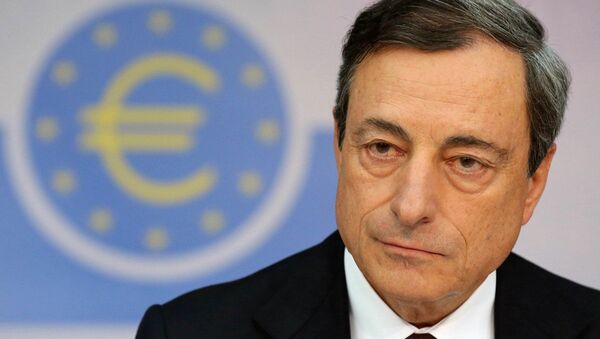MOSCOW, November 7 (RIA Novosti) — As the US Fed is set to further tighten monetary policy, optimistic US unemployment data have fanned market concerns that the regulator may raise interest rates sooner than previously believed, driving stocks down and leveraging further pressure on national central banks for monetary easing.
Asian markets slid Friday on anticipated US unemployment data, while the euro hit a two-year low on the European Central Bank announcement of more easing in order to boost growth in the Eurozone. The rest of world is somewhat feverish as well, as the Australian central bank expressed concern over the looming property market crash in Mainland China and aggressive easing in Korea and Japan, rendering the Aussie dollar so strong it may damage exports.
US unemployment data expected today, may show a significant boost in employment, which would be reason enough for the Fed to hike interest rates sooner than mid-2015, as previously announced. Investors are cautious as an era of more expensive money may be starting earlier. The Fed’s announcement has driven most Asian markets down with MSCI’s APEX-50 broader index of Asia-Pacific shares sliding 0.39%, having lost roughly 1.7% in a week, according to Bloomberg data. Hong Kong’s Hang Seng index decreased by 0.36%, Shanghai’s CSI 300 slid 0.16%, and S&P Asia lost 0.06%. Of all major Asian markets Japan’s Nikkei and Korea’s KOSPI have shown gains due to an unprecedented Bank of Japan stimulus and the expectations of a similar move to be carried out by the Bank of Korea. The former increased 0.54%, while the latter edged 0.18%.
US growth in non-farming sector payrolls, to be announced today, is estimated to increase by 231,000 jobs in October after a rise of 248,000 jobs in September, as estimated by Reuters. The Fed’s further monetary tightening depends on domestic macroeconomic data, the regulator said previously, most important of which is unemployment. The spillover effect of US monetary tightening for the rest of world is that money is becoming increasingly expensive, and most developed economies leverage pressure on national central banks to ease monetary policies and provide them with cheaper liquidity to replace the strengthening dollar.
The ECB’s further stimulus is looming, as the regulator’s head Mario Draghi said he would intensify stimulus in accordance with a solid consensus of European policymakers. Broader bond-buying is anticipated to start in December, as the ECB now prepares for the action by boosting its balance by $1.2 trln, Bloomberg reports. The euro fell on the news, which is a positive signal as weaker currency may help accelerate inflation and economic growth.
“Draghi signaled that additional monetary easing was in the pipeline,” Nick Kounis of ABN Amro Bank NV in Amsterdam said, as quoted by Bloomberg. “Further action could be announced as soon as next month’s meeting.”
Draghi’s remarks indicate that the ECB’s balance sheet is set to expand to its record capacity of 3 trln euros, last seen in March 2012. The regulator previously said the interest rate will remain at a record low of 0.05%. As the ECB takes a decisive position in regulating European finance, the roles of national central banks of individual Eurozone member states are increasingly diminishing.
“The 'main message' today is that 'ECB assets will expand as others contract.' As long as there is a risk of additional easing from the ECB, the euro will remain under pressure,” Kathy Lien of BK Asset Management in New York said as reported by Reuters.
In Australia, the nation’s central bank said today a strong local currency and the real estate market collapse in mainland China are challenging the nation’s economic growth and fostering uncertainty, which means easing measures will remain intact, as rate cuts are still deemed unnecessary.
“The very accommodative monetary policy settings will continue to provide support to demand and help growth to strengthen, in time,” the Reserve Bank of Australia said in a November monetary policy statement today. “On present indications, the most prudent course is likely to be a period of stability in interest rates,” the regulator added.
The RBA notes “a lower exchange rate would help to achieve more balanced growth in the economy." The recent massive quantitative easing by the Bank of Japan may trigger capital flows that would “hold the Australian dollar at a higher level than real economic fundamentals would imply.” This, along with China’s risks, may undermine Australian exports.
As the US Fed is set to sooner or later increase the interest rate, gradually rendering money liquidity more expensive, different parts of the world may respond with a ‘competitive easing’ of sorts, similar to the recent Japan-Korea development. As some nations will introduce more ambitious stimuli, spillover effects will force their neighbors to enforce similar policies. The result of such a situation will be cheaper exports internationally, while the US dollar is set to dominate against most major currencies in the medium term. This will create a huge imbalance between the supply and demand of global trade, and the global market is likely to oversaturate soon as commodity prices are already on a downward trend, as evidenced by Reuters data.

